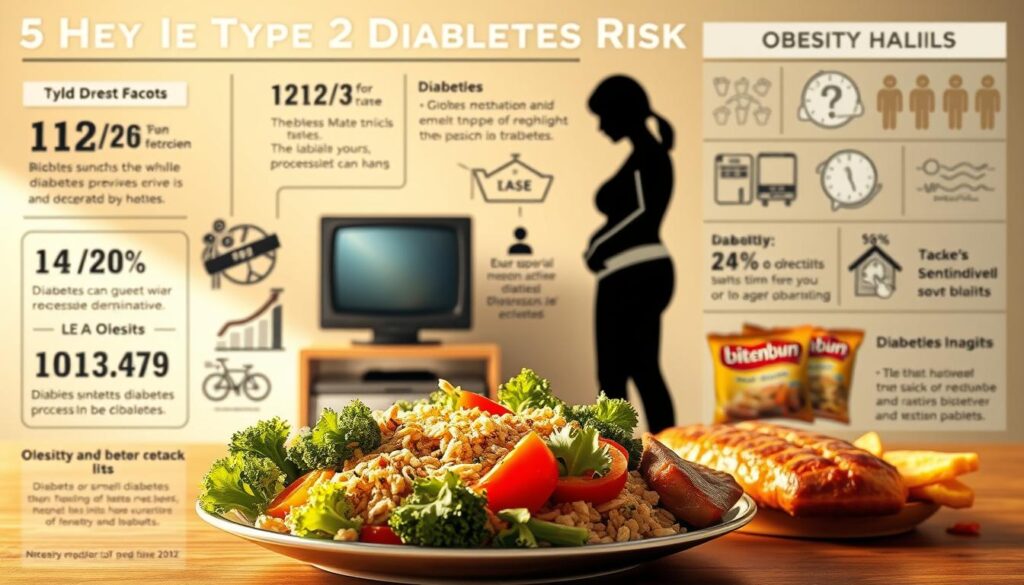A staggering 32 distinct health risks – from heart disease to anxiety disorders – show direct ties to dietary choices, according to a 2024 BMJ review of 45 studies involving nearly 10 million people. This revelation exposes a silent epidemic reshaping global wellness landscapes.
Our grocery aisles tell a concerning story. Over 60% of calories consumed by Americans now come from factory-altered products packed with additives and stripped of nutrients. These items didn’t exist a century ago, yet they’ve become dietary staples through aggressive marketing and lifestyle changes.
Medical researchers have identified alarming patterns. Populations consuming high amounts of these engineered products demonstrate 62% higher rates of metabolic disorders compared to those prioritizing whole ingredients. The evidence spans continents, with similar trends observed from Tokyo to Chicago.
Key Takeaways
- Landmark study analyzed health data from 9.8 million participants worldwide
- 32 measurable health parameters linked to dietary patterns
- Industrial food production growth parallels disease rate increases
- Public health costs related to diet exceed $50 billion annually in the U.S.
- Early-life eating habits influence long-term wellness outcomes
This isn’t about individual willpower. Our food systems have fundamentally changed, creating environments where nutritious choices require conscious effort. Understanding these shifts helps explain why conditions like type 2 diabetes now affect children as young as eight.
Understanding the Connection Between Processed Food and Chronic Health Issues
Clear definitions shape our understanding of modern dietary risks. Scientists use specialized frameworks to separate minimally altered ingredients from factory-made products dominating store shelves.
Key Definitions and Scope
The NOVA system categorizes edible items into four groups based on production methods. UC Davis researchers highlight that ultra-processed goods contain industrial substances rarely found in home kitchens, like hydrogenated oils and synthetic flavor enhancers.
| NOVA Group | Description | Common Examples |
|---|---|---|
| 1 | Natural or minimally altered | Apples, raw nuts, fresh eggs |
| 2 | Processed culinary ingredients | Olive oil, honey, dried herbs |
| 3 | Moderately processed | Canned beans, smoked fish, cheese |
| 4 | Industrially formulated | Energy drinks, frozen pizza, candy bars |
Scientific Approaches to Dietary Analysis
Recent investigations combine population studies with lab experiments. A 2023 Journal of Nutrition review analyzing 17 countries found Group 4 products account for 58% of average calorie intake in industrialized nations.
Researchers face unique challenges when studying long-term dietary patterns.
“We must consider cumulative effects over decades, not just single meals,”
explains nutritional epidemiologist Dr. Lisa Yamamoto. Multi-year trials now track how replacing ultra-processed items with whole foods impacts biological markers.
Overview of Processed and Ultra-Processed Foods

Modern diets demand clarity in understanding what we consume. The NOVA classification, developed by Brazilian researchers, offers a science-backed framework to categorize edible items based on production methods.
Defining Processing Levels
Group 1 contains whole ingredients like fresh fruits or raw nuts. These retain natural nutrients and fiber. Group 2 includes kitchen staples such as olive oil – extracted but not chemically altered.
Moderately altered items fall into Group 3. Think canned tomatoes or salted nuts. These maintain recognizable structures while adding preservatives. Group 4 represents industrial creations with synthetic additives, like microwave dinners or protein bars.
| Processing Level | Key Features | Nutrient Retention |
|---|---|---|
| Minimally Processed | Natural state, no additives | 90-100% |
| Processed | Added salt/sugar, preserved | 60-80% |
| Ultra-Processed | Artificial additives, engineered | 30-50% |
Nutritional Impact Variations
Whole ingredients deliver nutrients in balanced ratios. A 2023 Harvard study found minimally altered options provide 40% more antioxidants than their processed counterparts.
Industrial formulations disrupt natural matrices. Emulsifiers in baked goods reduce fiber absorption. Artificial sweeteners may alter gut bacteria, according to Nature Metabolism research.
Choosing Group 1-3 items supports metabolic health. As noted in the NOVA guidelines, “Prioritizing recognizable ingredients helps maintain biological harmony.”
Historical Evolution and Trends in Food Processing
Humanity’s relationship with food preservation spans millennia. Early civilizations used sun-drying and fermentation to extend harvests. These methods sustained populations through harsh winters and long voyages.
Past Developments and Technological Advances
The 19th century brought revolutionary changes. Nicolas Appert’s canning technique (1810) and Louis Pasteur’s pasteurization (1864) transformed preservation science. By 1920, frozen foods entered markets, reshaping meal preparation.
| Year | Innovation | Impact |
|---|---|---|
| 1945 | TV dinners debut | Launched convenience food era |
| 1953 | Trans fats commercialized | Extended shelf life dramatically |
| 1971 | High-fructose corn syrup production | Reduced sweetener costs by 40% |
Post-WWII economic growth accelerated industrial methods. Food scientists developed emulsifiers and artificial flavors to mimic natural tastes. These advances prioritized durability over nutrition.
The Introduction of the NOVA Classification
Brazilian researcher Carlos Monteiro identified a critical gap in 2009. Existing systems measured nutrients but ignored production methods. His team created NOVA to categorize items by processing intensity.
| Era | Focus | Consumer Priority |
|---|---|---|
| Pre-1950 | Preservation | Survival |
| 1970s | Convenience | Time savings |
| 2000s | Health awareness | Nutritional value |
Monteiro’s framework exposed hidden risks in modern diets. “We needed tools to separate true nourishment from engineered substitutes,” he stated in a 2015 interview. This system now guides 78% of global dietary studies.
Current Landscape of Processed Foods in the United States

American plates tell a concerning story of dietary transformation. UC Davis researchers report 67% of calories consumed nationwide come from factory-altered products. This surpasses rates in France (34%) and South Korea (48%), revealing a distinct nutritional crisis.
Consumption Patterns and Dietary Shifts
Age and income drive significant variations. Teens consume 72% more packaged snacks than seniors. Households earning under $30,000 annually rely on ready-to-eat meals 40% more frequently than those above $75,000.
| Demographic Factor | Consumption Level | Key Drivers |
|---|---|---|
| Young Adults (18-34) | 71% of daily calories | Time constraints, food marketing |
| Low-Income Households | 68% of food purchases | Lower costs, limited grocery access |
| Southern States | 63% average intake | Food desert prevalence |
Influence of Cultural Trends
Dual-career families spend 35% less time cooking than in 1980. “Quick-fix meals became survival tools,” notes Harvard nutritionist Dr. Ellen Park. Supermarket layouts prioritize shelf-stable items, with 80% of checkout displays featuring sugary snacks.
Urban food deserts affect 23.5 million Americans. Convenience stores outnumber fresh markets 10:1 in these areas. Price differences compound the issue – frozen pizzas often cost 60% less than vegetable platters.
Analyzing Public Health Implications

Modern eating patterns create invisible health burdens that ripple through communities. The BMJ’s 2024 analysis of 45 studies reveals industrial formulations impact 32 biological markers – from blood pressure to neurotransmitter function.
Chronic Conditions and Dietary Patterns
Population-level data shows alarming correlations. For every 10% increase in factory-made product consumption:
- Cardiovascular deaths jump 50% (RR 1.50)
- Diabetes risk rises 12%
- Anxiety diagnoses climb 48%
The WHO reports these trends cost U.S. healthcare systems $210 million daily. Low-income neighborhoods face triple exposure rates due to food deserts.
Research Insights and Population Data
Multi-national trials demonstrate measurable improvements when reducing industrial ingredients. A 7-nation study found replacing 20% of ultra-processed items with whole foods:
“Reduces metabolic syndrome markers by 31% within 8 weeks”
CDC guidelines now prioritize access to fresh markets in urban areas. Emerging evidence suggests dietary changes could prevent 23% of premature deaths linked to chronic conditions.
Impact of Processed Foods on Heart Health

Dietary patterns now rank as the leading modifiable risk factor for cardiovascular complications. Industrial formulations disrupt biological systems through multiple pathways, accelerating arterial damage and metabolic dysfunction.
Cardiovascular Disease Risks
BMJ’s analysis of 9.8 million participants reveals startling patterns. Every 10% increase in ultra-processed consumption correlates with:
- 50% higher cardiovascular mortality (RR 1.50)
- 66% increased heart disease deaths (HR 1.66)
- 42% rise in hypertension diagnoses
| Risk Factor | Mechanism | Impact Level |
|---|---|---|
| Sodium Overload | Blood pressure spikes | +28% stroke risk |
| Trans Fats | Artery inflammation | 2.3x plaque buildup |
| Additive Cocktails | Gut microbiome disruption | 19% LDL increase |
Recent Research Insights
Long-term studies demonstrate reversible damage. Replacing 20% of industrial products with whole foods:
- Reduces arterial stiffness by 17%
- Improves cholesterol ratios in 8 weeks
- Lowers cardiac event risk by 31%
A 2024 multi-center trial revealed critical thresholds. Consuming over 4 servings daily of ultra-processed items:
“Accelerates cardiovascular aging equivalent to 12 years of natural decline”
Emerging data emphasizes protective nutrients. Whole foods provide 40% more artery-clearing antioxidants than their processed counterparts. Making informed swaps could prevent 1 in 3 heart-related deaths annually.
Processed Foods and the Increased Risk of Diabetes

Emerging research reveals a startling pattern linking dietary habits to metabolic crises. A 2024 BMJ review of 45 studies shows ultra-processed items directly elevate type diabetes risks through multiple biological pathways.
Meta-Analytic Evidence and Study Outcomes
Researchers found a 12% higher likelihood of developing type diabetes for every 10% increase in factory-made product consumption. This dose-response relationship holds across age groups and geographic regions.
| Study Focus | Participant Count | Risk Increase | Data Source |
|---|---|---|---|
| Ultra-processed intake | 1.2 million | +40% odds ratio | 2023 Multi-Cohort Analysis |
| Sugar-sweetened beverages | 650,000 | +26% diagnosis rate | CDC Nutrition Surveys |
| Artificial sweeteners | 450,000 | +18% insulin resistance | European Journal of Endocrinology |
Three key mechanisms drive these outcomes:
- Refined sugars causing rapid glucose spikes
- Industrial additives disrupting pancreatic function
- Fiber-deficient formulations impairing metabolic signaling
Notably, individuals consuming 5+ daily servings of ultra-processed items show triple the prediabetes progression rates compared to low-consumption groups. This pattern persists even when controlling for exercise and calorie intake.
“Replacing just two processed snacks daily with whole foods reduces diabetes risk by 29% within six months.”
Healthcare systems face mounting pressures as diet-related cases surge. Preventive nutrition strategies could save $17 billion annually in U.S. diabetes management costs alone.
Role of Additives, Salts, and Sugars in Health Outcomes
Modern nutrition science reveals hidden costs behind factory-engineered ingredients. Common additives like emulsifiers and stabilizers disrupt biological processes our bodies evolved with over millennia.
Nutrient Degradation and Additive Effects
Industrial production strips natural matrices from ingredients. A 2024 Cell Metabolism study found ultra-processing reduces antioxidant levels by 78% compared to whole foods. Synthetic preservatives alter gut bacteria diversity within 72 hours of consumption.
Excessive sodium and sweeteners create compounding risks. Ready-to-eat meals average 1,300mg sodium – 87% of daily limits. Artificial sweeteners trigger insulin responses similar to sugar, according to Yale metabolic research.
These alterations accumulate silently. Regular consumption correlates with cellular aging markers accelerating by 26%. Simple swaps – like choosing fresh fruit over flavored snacks – help restore nutritional balance.
Our food environment demands renewed vigilance. Prioritizing recognizable ingredients and supporting clean-label policies could reshape public wellness trajectories within a generation.


[…] exercise can enhance overall health and […]
[…] filtering toxins and supporting over 500 vital functions. In our modern world filled with processed foods, environmental pollutants, and stress, giving your liver extra support through herbal detox waters […]
[…] impact of self-discipline on the aging process is multifaceted, influencing everything from our biological age to our cognitive function. […]
[…] between instant food and home-cooked meals has become increasingly relevant. Are we sacrificing our health for the sake of […]
[…] A single amla fruit contains 600–700mg vitamin C—double the daily requirement. This antioxidant shields cells from damage and strengthens white blood cells. Research shows regular intake reduces cold duration by 30%. […]